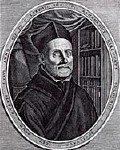
Athanasius Kircher
Athanasius Kircher (1602-1680) was a Jesuit Scholar and professor of Mathematics at the Roman College in Italy. He was one of the central figures of Baroque scientific culture, and probably the greatest expert on ancient and universal languages, archaeology, astronomy, magnetism, and Chinese and Egyptian culture in Europe at that time. However, despite his stature among European intellectuals, he was also reported to be the target of a number of pranks. It's uncertain whether any of these pranks actually happened, but the existence of the legends of these pranks indicates that the idea of intellectuals as being smart but lacking common sense is a very old one.
The Pranks
At one point, a rival named Andreas Muller concocted an unintelligible manuscript and sent it to Kircher with a note explaining that it had come from Egypt. He asked Kircher for a translation, and Kircher, reportedly, produced one at once.
At another time, some practical jokers sent a piece of silk paper to Kircher, similar to the kind known to be used in China. The paper was covered with strange characters. They asked Kircher to translate it, and Kircher duly set to work. After spending a few days attempting to interpret the inscription, he happened to see the characters reflected in a mirror, whereupon he saw that they were simply Roman characters printed in reverse. They formed this message written in Latin: ""Noli vana sectari et tempus perdere nugis nihil proficientibus," or, "Do not seek vain things, or waste time on unprofitable trifles."
Finally, a new building was being constructed in Rome. Some youths buried some stones on the construction site. On these stones they had carved various voluptuous figures and mysterious symbols. The stones were discovered when the foundation of the building was being dug, and they were widely admired as ancient relics. Kircher was asked to interpret them, and after admiring them he proceeded to give an elaborate interpretation of the circles, crosses, figures, and other meaningless signs with which they were inscribed.
An anonymous article in Littell's Living Age (vol. X, 1846, pp. 181-182) describes this prank:
Some youths, desirous of amusing themselves at the expense of Father Kircher, engraved several fantastic figures upon a stone, which they afterwards buried in a place where a house was about to be built. The workmen having picked up the stone while digging the foundation, handed it over to the learned Kircher, who was quite delighted with it, and bestowed much labor and research in explaining the meaning of the extraordinary figures upon it.
This final prank served as the basis for a later hoax directed against a different scholar,
Dr. Johann Beringer, in 1725.
Links and References
- Mencken, Johann Burkhard. The Charlatanry of the Learned. (De charlataneria eruditorum, 1715). Translated from the German by Francis E. Litz, with notes and an introduction by H. L. Mencken. "First edition." New York, London, A.A. Knopf, 1937.


Comments